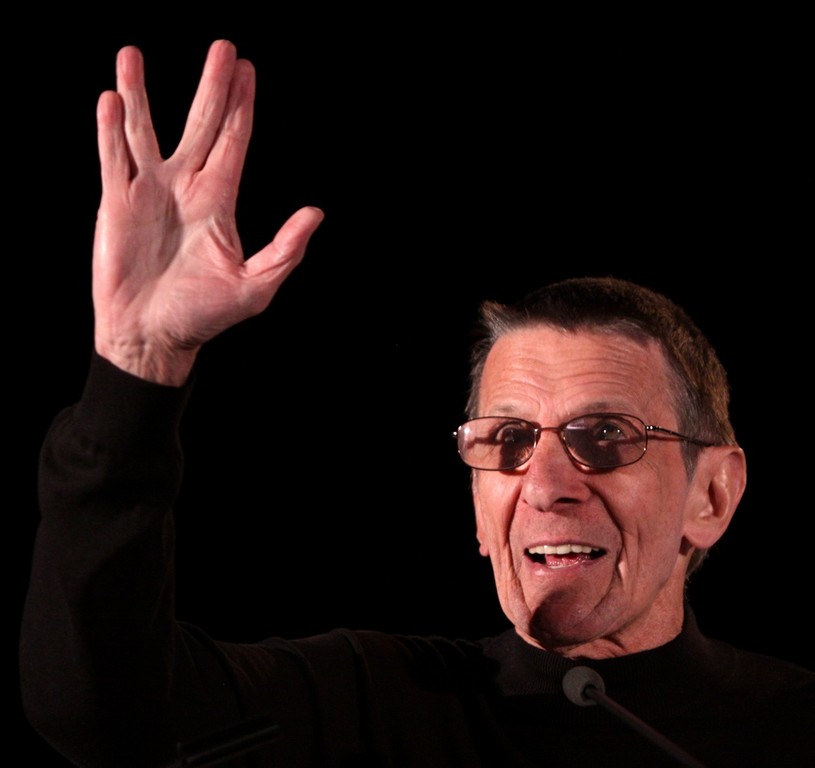Star Trek’s Leonard Nimoy has lived long and prospered
Leonard Nimoy says there is a “strong strain of Judaism” in everything he does — including his famous on-screen hand gestures.
Best known for his character Mr. Spock in the “Star Trek” television show and movies, most recently in his cameo as Spock Prime in this year’s blockbuster “Star Trek Into Darkness,” Nimoy’s Vulcan hand gesture comes from an experience he had at synagogue when he was eight years old.
Nimoy’s father told him not to look as worshippers averted their eyes during blessings recited by the kohanim.
“The men were chanting, shouting and praying in an Orthodox service,” Nimoy, 82, says in an interview with JNS.org. “It was very passionate, very theatrical. I was chilled by the whole thing.”
Years later, while on the set of the “Star Trek” television show, Nimoy suggested to the director that Vulcans like Spock should offer some gesture in greeting other Vulcans.
“The director asked me what I had in mind and I suggested the gesture used by the kohanim,” Nimoy says. The gesture went on to be accompanied by the expression “live long and prosper.”
Nimoy, born in Boston, recalls he grew up “in a very Jewish environment and was bar mitzvahed appropriately when I was 13.”
“The neighborhood I grew up in had several synagogues, and I sang in the choirs for the High Holidays,” he tells JNS.org. “There is a strong strain of Judaism in everything I do. It is a presence that I do not deny and do not want to deny. It is a valuable resource for me and a valuable part of my consciousness.”
Born to Yiddish-speaking Orthodox Jews from Ukraine, Nimoy narrated the documentary “A Life Apart: Hasidism in America” in 1997, about the various sects of Hassidic Jews. In October 2002, Nimoy published “The Shekhina Project,” a photographic study inspired by Kabbalah, exploring the feminine aspect of G-d’s presence that “struck some as revolutionary and others as salacious,” according to gallery owner Rich Michelson.
“There were some synagogues that refused to show the work, and others that canceled speaking engagements,” he said.
Nimoy has a long list of activities he has participated in that are linked to his Judaism.
He produced and starred, with Dabney Coleman and Blythe Danner, in a television movie called “Never Forget.” Written by Ronald Rubin, the 1991 film is a dramatization of a Holocaust survivor who confronted a Holocaust denial organization’s lies in court. Nimoy met the survivor, Mel Mermelstein.
“Mermelstein’s family was taken into Auschwitz during the second World War,” Nimoy says. “His siblings and parents were killed. He won his lawsuit, but more importantly, the subject of the Holocaust went into American law for the first time in 1979. It became a legal fact.”
Nimoy was awarded an honorary degree by his alma mater, Antioch University, in part for his activism in Holocaust remembrance.
On a lighter note, he “surprised a lot of people by playing Tevye in ‘Fiddler on the Roof’ in 1971 on an eight-week eastern tour that was very successful,” he says.
Nimoy’s portrayal of Mr. Spock in “Star Trek” earned him iconic status as well as three Emmy nominations. But aside from his numerous credits as an actor and director, Nimoy is also a successful recording artist, author and photographer.
“There is no doubt that Nimoy will always be identified foremost with Mr. Spock,” Michelson says. “But he is no dilettante with the camera.”
Yet, Mr. Spock remains the most enduring aspect of Nimoy’s fame. First airing in 1966, the character would become an icon over the years as “Star Trek” branched off into syndication and later onto the big screen as a series of six feature films. Being identified with one of the most recognizable characters in television history is intriguing to Nimoy, and it is something he embraces.
“I admire Spock,” Nimoy says.
“Spock claims to be other than human but he’s a terribly human character,” he adds. “That’s what makes him so attractive. People understand him and identify with him. His dilemma is a human dilemma. Teenagers really understand what Spock is dealing with, which is finding the proper balance between logic and emotion.”

 50.0°,
Overcast
50.0°,
Overcast 




